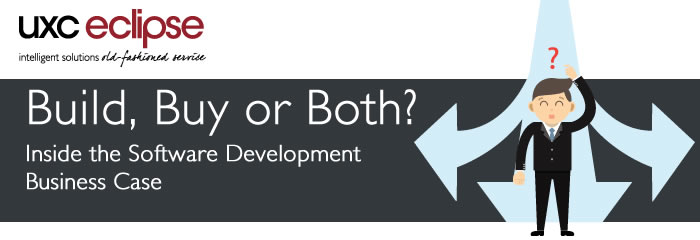Oliver Strutt, UXC Eclipse Technical Manager – Microsoft Dynamics AX, looks at the different software development project factors…
One of the early decisions to be made in any IT project implementation is the extent to which it makes sense to purchase an off-the-shelf solution, build a solution from scratch, or find a middle ground in which an off-the-shelf solution is customised to suit the organisation’s needs.
Some of the obvious considerations to take into account include whether the chosen solution will fit the organisation’s needs, whether the organisation can bear the costs involved in implementing its chosen solution, and whether the organisation has the internal resources and skills needed to adequately implement and manage the solution.
Through many years of experience, UXC Eclipse has identified three additional factors to consider when deciding whether to build, buy or both:
1. Industry benchmarks
The decision to build, buy or both can be influenced by competitor behaviour. For example, if competitors are all building their own solutions rather than buying, it could mean that there is no industry-specific out-of-the-box package available, or that those available have not performed well. Benchmark against peers to gauge whether there is a commercial solution available.
2. Quality assurance
There are quality assurance benefits in the decision to buy. Purchasing an industry-certified solution will reduce risk. It also provides some level of assurance that what is being delivered will meet organisational requirements based on existing use cases and available references.
Building or adding complex customisations, on the other hand, can create questions around quality assurance. Understanding whether the organisation and/or the vendor are capable of delivering is the key.
3. Upgrades, support and best practice
Buying a solution lets organisations leverage upgrades, which can introduce additional functionality and fixes. This can lower the total cost of ownership of the solution over time as it continues to deliver a return on investment.
Access to product support and a development roadmap are also generally provided as part of any maintenance package offered when an organisation buys a solution.
Building a solution means there is less impetus to upgrade since there is no base product supplied by a vendor. This means any additional functionality or fixes that are required must be developed specifically for that purpose, which tends to carry a significant additional cost since the development cost cannot be mitigated across a number of customers.
For this reason, upgrades are generally only considered if new technologies emerge that warrant the change or if skill sets for the existing product technology are hard to find. The end-user desire for enhancement often drives demand for upgrades so if the best possible solution is built upfront then a lack of upgrades is unlikely to be a major barrier.
If the chosen solution is a customised of-the-shelf one then it becomes important to be strategic when making modifications based on the product roadmap. This is a good option if the intent is to accelerate development. It gives organisations a head start and a platform to develop on. Organisations in this position should also be aware of future upgrade costs for enhancements.
You can read more on this topic by downloading our free White Paper – Build, Buy or Both?
ARTICLE SUPPLIED BY//
UXC Eclipse
Australia
W: www.uxceclipse.com.au
E: info@uxceclipse.com.au
New Zealand
W: www.uxceclipse.co.nz
E: info@uxceclipse.co.nz



















